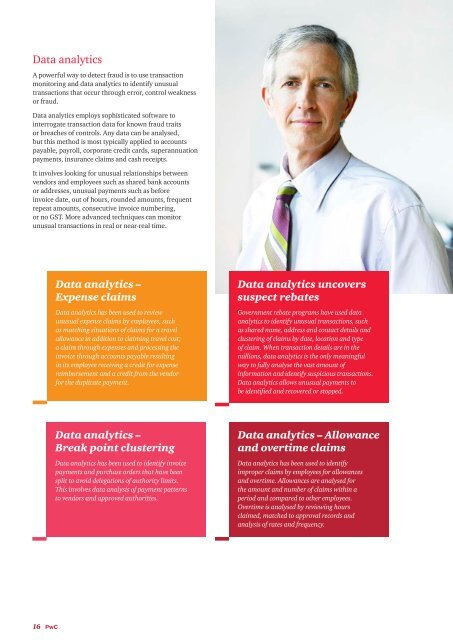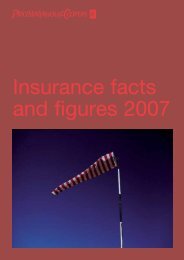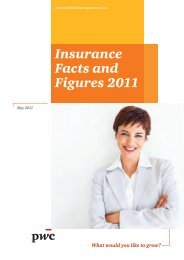Controlling fraud in the public sector - PricewaterhouseCoopers
Controlling fraud in the public sector - PricewaterhouseCoopers
Controlling fraud in the public sector - PricewaterhouseCoopers
Create successful ePaper yourself
Turn your PDF publications into a flip-book with our unique Google optimized e-Paper software.
Data analytics<br />
A powerful way to detect <strong>fraud</strong> is to use transaction<br />
monitor<strong>in</strong>g and data analytics to identify unusual<br />
transactions that occur through error, control weakness<br />
or <strong>fraud</strong>.<br />
Data analytics employs sophisticated software to<br />
<strong>in</strong>terrogate transaction data for known <strong>fraud</strong> traits<br />
or breaches of controls. Any data can be analysed,<br />
but this method is most typically applied to accounts<br />
payable, payroll, corporate credit cards, superannuation<br />
payments, <strong>in</strong>surance claims and cash receipts.<br />
It <strong>in</strong>volves look<strong>in</strong>g for unusual relationships between<br />
vendors and employees such as shared bank accounts<br />
or addresses, unusual payments such as before<br />
<strong>in</strong>voice date, out of hours, rounded amounts, frequent<br />
repeat amounts, consecutive <strong>in</strong>voice number<strong>in</strong>g,<br />
or no GST. More advanced techniques can monitor<br />
unusual transactions <strong>in</strong> real or near-real time.<br />
Data analytics –<br />
Expense claims<br />
Data analytics has been used to review<br />
unusual expense claims by employees, such<br />
as match<strong>in</strong>g situations of claims for a travel<br />
allowance <strong>in</strong> addition to claim<strong>in</strong>g travel cost;<br />
a claim through expenses and process<strong>in</strong>g <strong>the</strong><br />
<strong>in</strong>voice through accounts payable result<strong>in</strong>g<br />
<strong>in</strong> its employee receiv<strong>in</strong>g a credit for expense<br />
reimbursement and a credit from <strong>the</strong> vendor<br />
for <strong>the</strong> duplicate payment.<br />
Data analytics uncovers<br />
suspect rebates<br />
Government rebate programs have used data<br />
analytics to identify unusual transactions, such<br />
as shared name, address and contact details and<br />
cluster<strong>in</strong>g of claims by date, location and type<br />
of claim. When transaction details are <strong>in</strong> <strong>the</strong><br />
millions, data analytics is <strong>the</strong> only mean<strong>in</strong>gful<br />
way to fully analyse <strong>the</strong> vast amount of<br />
<strong>in</strong>formation and identify suspicious transactions.<br />
Data analytics allows unusual payments to<br />
be identified and recovered or stopped.<br />
Data analytics –<br />
Break po<strong>in</strong>t cluster<strong>in</strong>g<br />
Data analytics has been used to identify <strong>in</strong>voice<br />
payments and purchase orders that have been<br />
split to avoid delegations of authority limits.<br />
This <strong>in</strong>volves data analysis of payment patterns<br />
to vendors and approved authorities.<br />
Data analytics – Allowance<br />
and overtime claims<br />
Data analytics has been used to identify<br />
improper claims by employees for allowances<br />
and overtime. Allowances are analysed for<br />
<strong>the</strong> amount and number of claims with<strong>in</strong> a<br />
period and compared to o<strong>the</strong>r employees.<br />
Overtime is analysed by review<strong>in</strong>g hours<br />
claimed, matched to approval records and<br />
analysis of rates and frequency.<br />
16 PwC
















